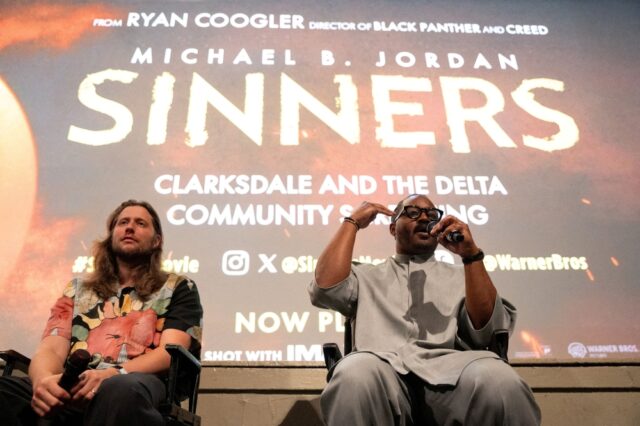LOS ANGELES, July 5 — Vampires, zombies and the Grim Reaper are killing it at the box office.
At a time when superheroes, sequels and reboots have grown stale among audiences, horror has emerged as an unlikely savior, entertainment industry veterans say. This year, scary movies account for 17 per cent of the North American ticket purchases, up from 11 per cent in 2024 and 4 percent a decade ago, according to Comscore data compiled exclusively for Reuters. Thanks to the box office performance of Sinners and Final Destination: Bloodlines, and new installments of popular horror films hitting later this year, including The Conjuring: Last Rites and Five Nights at Freddy’s 2, cinema owners have reason to celebrate.
“We have identified horror as really one of the primary film genres that we are targeting to grow,” said Brandt Gully, owner of the Springs Cinema & Taphouse in Sandy Springs, Georgia. “It can really fill a void when you need it.”
Producers, studio executives and theater owners say horror has historically provided a safe outlet to cope with contemporary anxieties. And there is no lack of material to choose from: the aftershocks of a global pandemic, artificial intelligence paranoia, the loss of control over one’s body, and resurgent racism.
“It’s cathartic, it’s emotional, and it comes with an ending,” said film data analyst Stephen Follows, author of the Horror Movie Report, which offers detailed insights into the genre. “Horror movies give space to process things that are harder to face in everyday life.”
The often low-budget productions allow for greater risk-taking than would be possible with high-cost, high-stakes productions like Mission: Impossible—The Final Reckoning. The creative freedom has attracted such acclaimed directors as Ryan Coogler, Jordan Peele, Danny Boyle and Guillermo del Toro.
“Horror movies are an accountant’s dream,” said Paul Dergarabedian, Comscore senior media analyst. “If you’re going to make a science-fiction outer-space extravaganza, you can’t do that on the cheap. With horror films, a modest-budget movie like Weapons can bescary as hell.”
Audiences are responding. Coogler’s Sinners, an original story about Mississippi vampires starring Michael B. Jordan,was theyear’s third highest-grossing movie in the US and Canada, according to Comscore. Movie theaters are still recovering from the Covid-19 pandemic which broke the movie-going habit, and increased viewing in the home. Mike De Luca, co-chair and Warner Bros Motion Picture Group, which released Sinners, said horror was a genre that manages to get people out of the house.”
It’s a rising tide that lifts all boats,” he said. “You know, we’re trying to get people back in the habit of going to the theaters.”
Fear knows no geographical bounds.
Half of all horror movies released by major US distributors last year made 50 percent or more of their worldwide box office gross outside the US, according to London-based researcher Ampere Analysis.
The breakout international hit The Substance, for example, grossed over US$77 million (RM325 million) worldwide—with around 80 per cent of that from outside the US Streamers also are similarly capitalising on the appeal of the genre.
AMC’s post-apocalyptic horror drama series The Walking Dead, became one of the most popular series when it was added to Netflix in 2023, amassing 1.3 billion hours viewed, according to Netflix’s Engagement Report. Director Guillermo del Toro’s film adaptation of Mary Shelley’s gothic novel, Frankenstein, is set to debut in November.
Date night
Horror films are ideally suited to watching in movie theaters, where the environment heightens the experience.
“What you can’t do at home is sit in a dark room with a hundred other people, not on your phone, and jump,” said Blumhouse CEO Jason Blum, producer of Halloween, Paranormal Activity and other lucrative horror franchises.
“You can’t really be scared when you watch a horror movie at home.”
Big-budget movies that the industry refers to as “tent poles,” such as Captain America: Brave New World or A Minecraft Movie, remain the lifeblood of movie theaters. Over time, these blockbusters have elbowed out more moderately budgeted romantic comedies and dramas on movie screens.
Against this backdrop, horror has been quietly gaining momentum.
The genre broke the US$1 billion box office barrier in the US and Canada for the first time in 2017, Comscore reported, buoyed by the film adaptation of Stephen King’s novel, It, and Jordan Peele’s exploration of racial inequality in Get Out.
Announcements of new horror films from US producers have risen each year for the last three years, including in 2023, when the Hollywood strikes significantly impacted production, according to Ampere Analysis.
The number of US horror films that went into production last year was up 21 per cent over 2023, Ampere found. “While more arthouse fare and even some tentpole superhero franchises have had mixed fortunes at the global box office in the wake of the pandemic, horror remains one of the key genres that audiences still make a point of seeing in the theatres,” wrote researcher Alice Thorpe in a report for Ampere’s clients which she shared with Reuters.
The researcher’s own consumer surveys revealed horror is the favorite genre among two-thirds of movie-goers, ages 18 to 24.
“Anytime a teenager graduates to wanting to take a date to the movies, horror gets popular really fast,” said Warner Bros’ De Luca. “It’s a great film-going experience to take a date to because you get to huddle with each other and gasp and hoop and holler.”
Freak show
Horror has been a cinematic staple from its earliest days, when Thomas Edison filmed Frankenstein on his motion picture camera, the Kinetograph, in 1910. The British Board of Film Classification introduced the “H” rating in 1932, officially designating the genre.
But it didn’t always get Hollywood’s respect.
“In the first half of the 20th century, it was seen as a freak-show,” said Follows. Perceptions began to change with the critical and commercial success of films like Psycho, The Exorcist and The Shining. Director Steven Spielberg ushered in the summer blockbuster in 1975 with Jaws, a re-invention of the classic monster movie.
In recent years, horror movies have become part of the Oscar conversation.
Peele collected an Academy Award for best original screenplay in 2018 for Get Out. Demi Moore received her first Oscar nomination earlier this year for her portrayal of an aging Hollywood star who will go to any lengths to stay beautiful in The Substance.
Not every horror movie connects with audiences.
M3GAN 2.0, a sequel to the 2022 low-budget film about a killer robotic doll that grossed US$180 million worldwide,brought in a modest US$10.2 million in the US and Canada in its opening weekend, according to Comscore.
Theatre chains will have no shortage of horror movies to exhibit this summer. Seven films are slated to be released before Labour Day weekend, including Columbia Pictures’ nostalgic reboot of the 1997 film, I Know What You Did Last Summer, which reaches screens on July 18, and Weapons, which opens on August 8.
“The best types of these movies are ones that elicit an audible and visceral reaction … ‘Don’t go in there!’” said Screen Gems President Ashley Brucks, who has worked on such films as Sony’s upcoming I Know What You Did Last Summer as well as A Quiet Place and Scream.
“You are either squirming or laughing or screaming and just really having fun with it.” — Reuters











